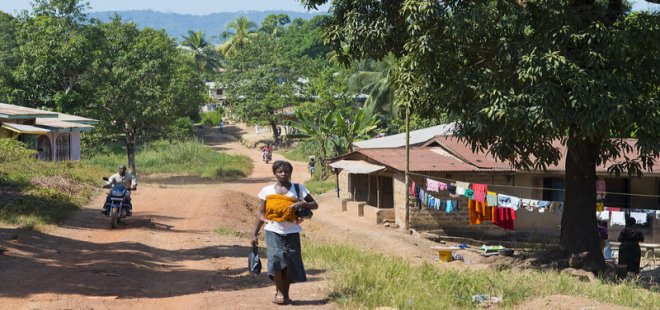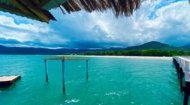Daily Life in Sierra LeoneTags: Life in Sierra Leone, Daily Life in Sierra Leone, Life in Sierra Leone Housing, Life in Sierra Leone Healthcare, Family Life in Sierra Leone, Rural Life in Sierra Leone |
|
Life in Sierra Leone |
Life in Sierra Leone |
Life in Sierra Leone | Life in Sierra Leone |
Facts, videos, articles and information about the situation in Sierra Leone in our profile pages.
More >
|

|
Outside major conurbations, life in Sierra Leone means living in a clay and earth structure made from blocks dried in the sun, together with a thatch roof (above) although increasingly zinc sheets for roofs and cement to cover floors and walls are becoming more commonsplace as they require less maintenance. While these structures are adapted to the climate, they often lack basic amenities. Access to clean, safe drinking water is a daily struggle for a significant portion of the population. Women and children can spend hours each day walking to the nearest well or borehole to fetch water, a time-consuming task that detracts from education and other economic activities. Sanitation infrastructure is similarly underdeveloped, with limited access to proper latrines, which contributes to the spread of waterborne diseases like cholera and typhoid, placing an immense strain on an already fragile healthcare system. The diet is primarily rice based and supplemented by cassava leaves, peppers, beans, onions etc and, for those with a larger budget or on special occasions, eaten with fish, beef or chicken. The cooking area is where children will usually congregate after eating to hear stories and receive instruction from their elders in a society that is noted for its politeness and good manners. There are no streets as such in Sierra Leonean villages, just clusters of houses constructed as and where their anacestors owned land, however each village has its own shops and market places as well as a chuch/mosque, village school and latrines and often a cemetary on the borders of the village. Life in Sierra Leone is fairly typically for that in Africa with women subordinate to the men they marry with those men undertaking most physically intense work such as clearing fields and seeing to the swamps, known as 'Bolilands', with 'boli' a Temne word for lands that are flooded in the rainy season and dry and hard in the dry season, most prevelant along coastal areas. Planting, harvesting, weeding, gathering wood, cooking, cleaning, marketing, and child care are duties normally the preserve of women, assisted by the younger children, especially girls. The youngsters rarely see this as a burden, rather a mark of pride in their ability to contribute to the welfare of the household. There are sixteen main ethnic groups and the Krio language is spoken by 90% of the population despite English being the official country language and Sierra Leoneans are 60% Muslim, 10% Christian, while around 30% are 'indigenous believers'. Religion is a deeply woven thread in the fabric of daily life in Sierra Leone, providing spiritual guidance, social structure, and a source of hope. The nation is notable for its remarkable religious tolerance, and it is common to find families with members of both faiths, and major religious holidays like Eid and Christmas are often celebrated by the entire community, regardless of individual belief. This peaceful coexistence is a source of immense national pride and serves as a powerful example of unity in a region that has often been marked by religious strife. Mosques and churches are not just places of worship, but central community hubs for social gatherings, education, and support. A look at the statistics reveals the stark realities that shape the nation. With a population of over 8 million people, Sierra Leone has one of the youngest populations in the world. However, it also faces significant developmental hurdles. Life expectancy hovers around 60 years, among the lowest globally. The official literacy rate is below 50%, a figure that masks a significant gender gap and a stark divide between urban and rural access to schooling. The economy is heavily reliant on subsistence agriculture and mining, particularly of diamonds, rutile, and iron ore. While rich in natural resources, the country has struggled to translate this wealth into widespread prosperity for its citizens. The pursuit of education is highly valued by families, who see it as the most viable pathway out of poverty. The government's introduction of the Free Quality School Education program was a monumental step towards making primary and secondary education accessible to all. Despite this progress, the system is fraught with challenges. Classrooms are often severely overcrowded, learning materials are scarce, and there is a shortage of qualified teachers, especially in remote villages. Many children, particularly girls, still face barriers to completing their education due to household responsibilities, early marriage, or the financial pressure to contribute to the family's income. The fundamental conditions of housing, water, and sanitation remain among the most critical issues affecting daily life in Sierre Leone for the majority. The video, (above, left) provides further inights into life in Sierra Leone and there is further information on our Sierra Leone profile and children's lives pages. |









